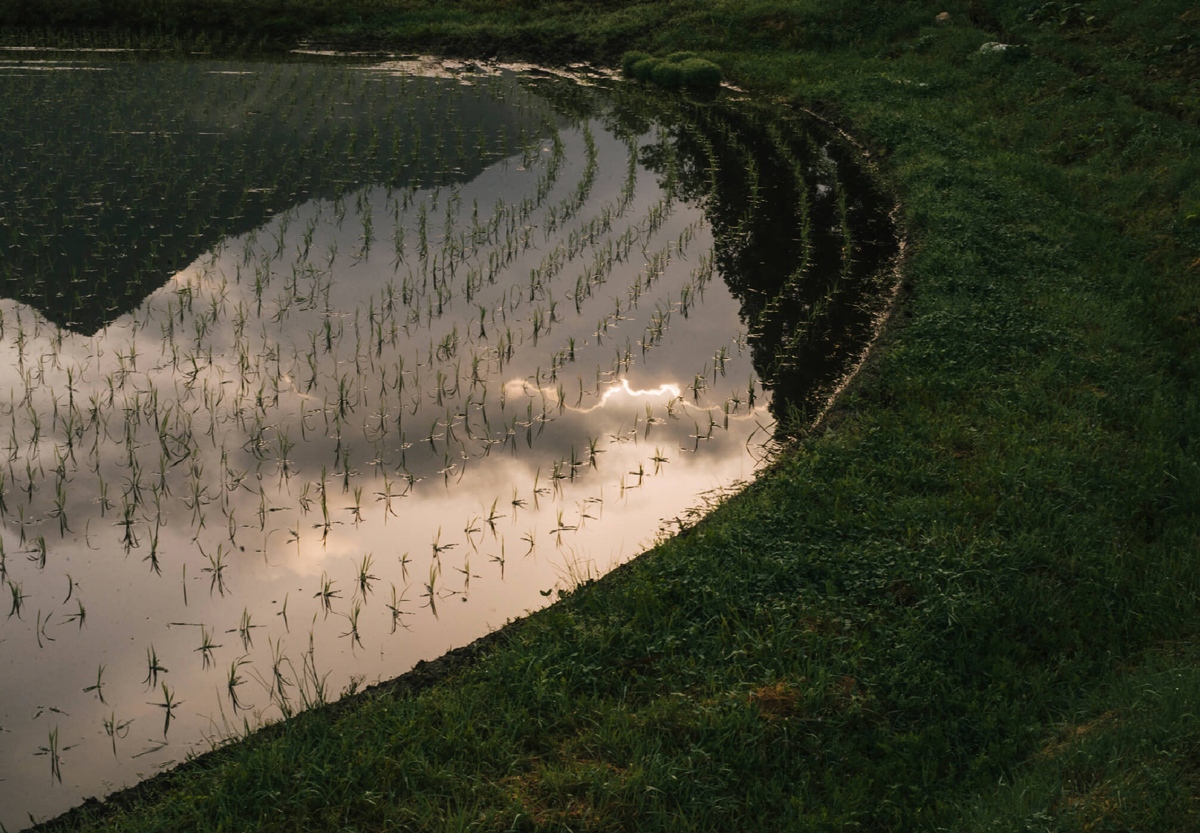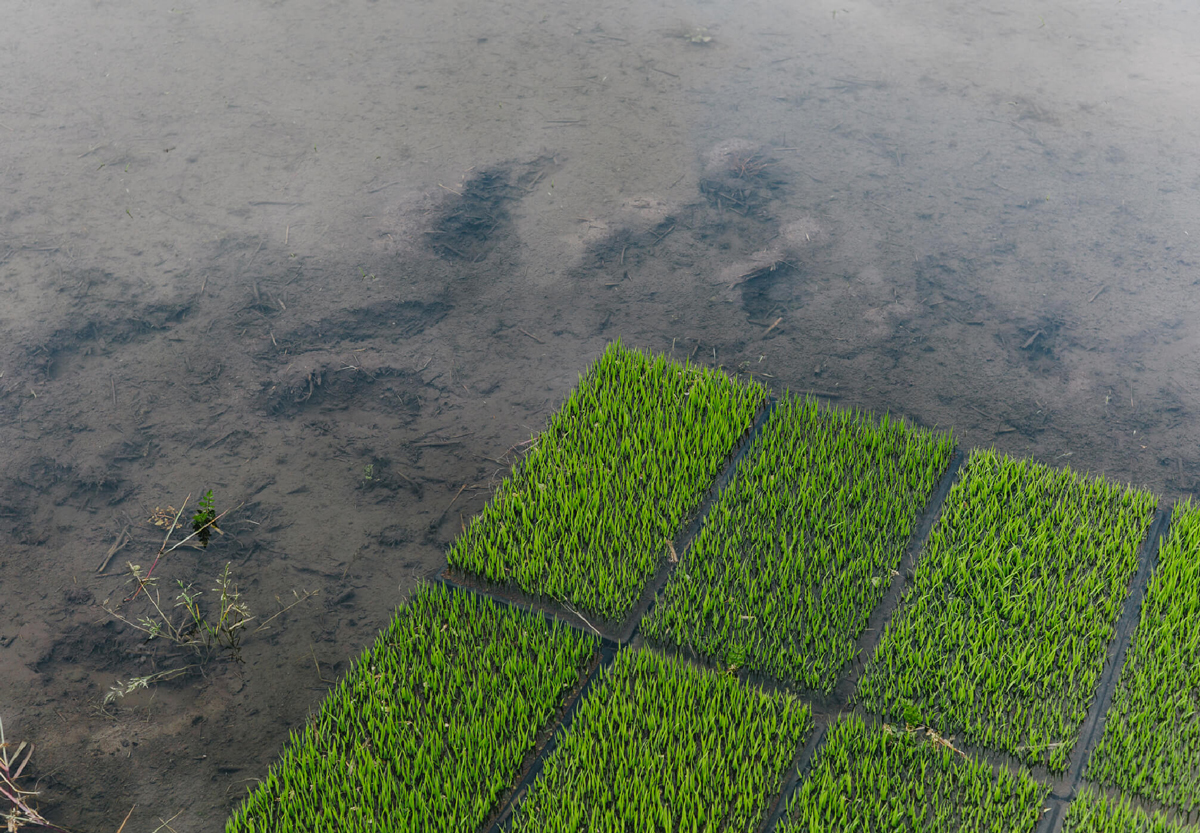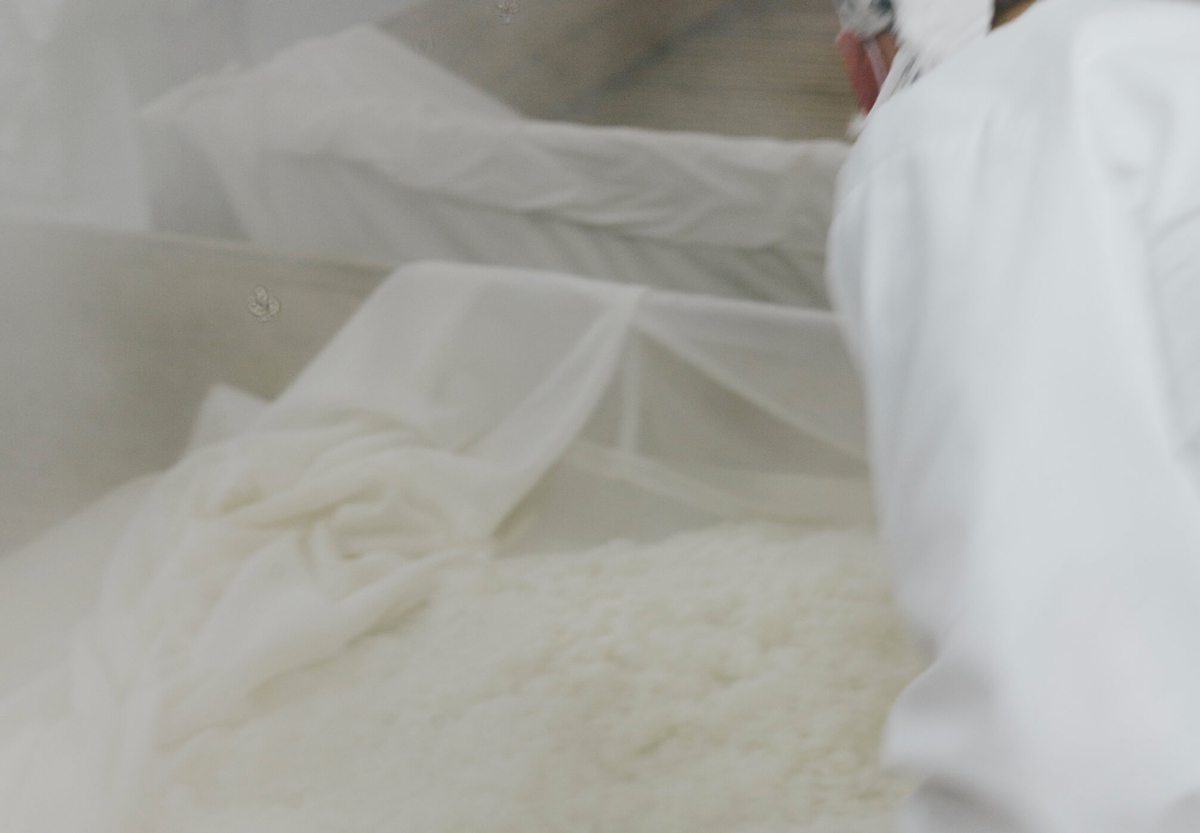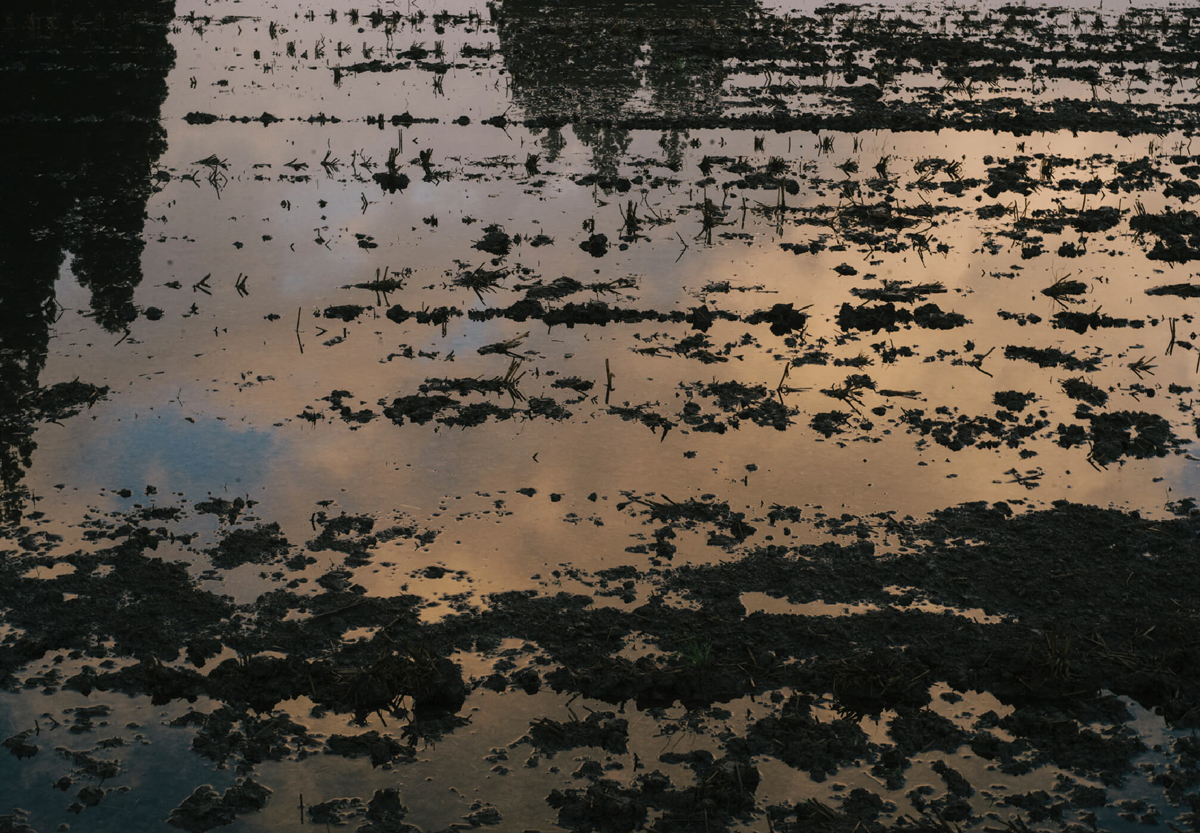自然は、人間の鏡。とても偉大な存在だけれど、人間の営みと隣り合わせにあるもの。今、世界中で起こっている自然災害や様々な環境問題は、私たちが自然と向き合わなければならないという地球からのメッセージなのではないでしょうか。豊かな環境になれば、川も海も山も、きっと穏やかであり続ける。日本酒を通じて自然や環境のことを見直したいし、できる限り寄り添っていきたいと考えています。
I believe that nature is a mirror of human beings. It's a very great being, but it's right next to our daily lives. Natural disasters and various environmental issue that we are currently facing around the world are a message from the earth that we must face nature, I think. If the environment could become richer, then rivers, oceans and mountains might have remain calm. I want to rethink nature and the environment through sake, and coexist in harmony as much as I can.

― 米、水、土壌、発酵……。当然のことながら、自然の存在なしに日本酒は語れません。猪本さんが考える日本酒の魅力とは。
— Rice, water, soil and fermentation ... Indeed, it is impossible to talk about sake without the presence of nature. What Ms. Inomoto sees the attractiveness in sake?
自然と日本人の気質から生まれた日本酒
少し乱暴な表現ですが、ぶどうなど果物はそのままが糖なのでそのまま放っておいても発酵しますが、米をアルコール発酵させるためには、酵母を糖に変えなくてはならず、さらにそのためには麹が必要で……とよくそんな工程に行き着き、日本酒を造るに至ったなあと。自然の現象だけでなく、先人たちの緻密さや生真面目さといった日本人特有の気質があったからこそ日本酒は生まれたのではないでしょうか。それこそが日本酒の魅力だと思っています。
Sake born of nature and the Japanese spirit
It's a bit rough, but fruits such as grapes can be left alone to ferment because they are sugars in themselves. But in order to ferment rice into alcohol, starch must be converted into sugar, and koji (malted rice) is also needed for the yeast to do so…… I believe that Sake was born not only because of those natural phenomena, but also with a result of the diligence and serious personalities of our pioneers, which can be often found in Japanese people. This is what makes Sake appealing.

― 今回(THISIS)SHIZENにおいて、日本酒ディレクターという肩書きを担う猪本さん。このプロジェクトならではの想いやセレクトへのこだわりがあると思います。
— Ms. Inomoto’s thoughts and her vision for the selection process.
(THISIS)SHIZENの日本酒ディレクターという役割
(THISIS)SHIZENのディレクターの齊藤太一さんから日本酒のディレクションをしてほしいとお話をいただき、コンセプトをうかがって、とても楽しみなプロジェクトだと感じました。日本酒って若い女性からするとまだまだおじさんの飲み物、というようなイメージが強い。いいものを造っていて、こんなに魅惑的なのに、打ち出しや広がり方が追いついていないことも多く、勿体ないなと思うんです。ですから、今回(THISIS)SHIZENに対する齊藤さんのアイデアや考え方が、今までにはない視点で、お酒業界の新たな切り口になればと思っています。
The role of 'Sake Director' for (THISISIS)SHIZEN
When I heard about the concept from (THISISIS)SHIZEN's director, Taichi Saito, I felt that this is a project I can be very excited about. Sake still has a stigma among young women in Japan that it is old men's drink. I think this is such a shame that even if it is such a good product and fascinating, the way it is presented and the way it spreads hasn't caught up to its fascination. That's why I am hoping that Mr. Saito's ideas and approach to (THISIS)SHIZEN will bring a new perspective to the sake industry.

今回のオープン時には、4種類の日本酒を揃えました。秋田の新政酒造の「新政」、石川の吉田酒造の「u yoshidagura」、熊本の千代の園酒造「産山村」、そして京都の松本酒造で造った(THISIS)SHIZENオリジナルというラインナップです。
このプロジェクトがスタートした時、最初に新政酒造の8代目、佐藤祐輔さんの元を訪ねました。彼はこの10年で、 日本酒造りに使われる添加物を一切加えず、自然の力を活用した伝統的な製法、生酛(きもと)造りに切り替えるなど、日本酒の原点に立ち返った酒造りを行う彼の考えや姿勢は、きっと(THISIS)SHIZENに合うのではないかと思ったからです。それから、古典的な山廃仕込みをモダンに仕上げた吉田酒造や、農薬を使わずに鯉を放して害虫を食べてもらう鯉農法の米から造る、私の地元熊本の産山村にも参加いただきました、そして、(THISIS)SHIZENがある京都の酒蔵でオリジナルの日本酒を造ろうと、松本酒造へ相談を持ちかけました。松本酒造の松本日出彦さんにこの件を相談したところ、すぐに「田んぼに行こう」と、兵庫県にある山田錦が生産される田んぼの中でも特A地区に連れて行ってくれました。彼らも昨年から自社栽培をスタートしたのですが、その集落にある田んぼの1枚を(THISIS)SHIZEN用としてくれたことで、実現に至りました。
私たち酒屋は自分たちで造って売ることはできません。だからこそ蔵元をどうセレクトして、どう関係をつくり自分なりコミュニケートしていくかは常に大切なこと。今回の(THISIS)SHIZENのためのセレクトも、「自然」というこの店のコンセプトを理解した上で選ばせてもらいました。
For the opening, we provided four types of sake. 'Aramasa' from Aramasa Brewery in Akita, 'u yoshidagura' from Yoshida Brewery in Akita, 'Ubuyamamura' from Chiyonosono Brewery in Kumamoto, and (THISIS)SHIZEN original Sake from Matsumoto Brewery in Kyoto.
When this project has started, we first visited Yusuke Sato, the 8th generation of Shinsei Shuzo, who has been working on this project for 10 years. Over the past 10 years, he has switched to the traditional method of making sake without adding additives and harnessing the power of nature, called "Kimoto method”. I thought his ideas and approach to sake brewing would be a good fit for (THISIS)SHIZEN. Then, I invited Yoshida Brewery, where use a modern take on the classic Yamahai brewing method, and also invited a brewery from my hometown, Ubuyama in Kumamoto, where makes sake from rice produced by a carp farming method that releases carp without using pesticides to eat pests. After that, I approached Matsumoto Brewery in Kyoto for advice to make an original sake of (THISIS)SHIZEN. When I discussed this matter with the owner Hidehiko Matsumoto, he immediately said, "Let's go to the rice paddies" and he took us to the Special A area among the rice paddies in Hyogo Prefecture that produce Yamada Nishiki (a speciality rice for sake-making). They started growing their own rice by themselves last year, and they gave us one area of their rice paddies for (THIS)SHIZEN, we were able to make it happen to make an original sake.
We, as liquor stores, cannot make sake by ourselves. That's why it is always important how we select breweries and build relationships with them to communicate in our own way. Therefore, our selections for (THISIS)SHIZEN were made with an understanding of the store's concept of "nature" in our own perspective.

Photography by Ko Tsuchiya
― 家業に携わるようになって10年を経て、現在2代目を担う猪本さん。自身とその環境における変わったことと変わらないこと。
— Ms. Inomoto, who is currently the second generation owner, has been involved in her family business for 10 years. What has changed and what has not changed for herself and her environment?
人も自然も、皆本来あるべき姿へ
蔵も蔵人も、みんな心血を注いで日本酒を造っています。今、米の自社栽培も増えていて、自分たちが育てた米で日本酒を造りはじめています。自然のサイクルに合わせて営む、本来の酒蔵の姿だと思うんです。父が築いた酒屋を自身でシャッターを降ろさせるわけにはいかないと思い立ち、東京から熊本に戻りこのお酒の業界に入って10年。とてもいいタイミングで今回のようなプロジェクトに関わらせてもらっているなと感じています。私たち酒屋は、蔵元のお酒を預かって消費者に届ける「橋渡し役」です。その際、どんな人がどんな環境で、どんな想いを込めて造られているかというメッセージも添えて、届けているんです。酒蔵はもちろん、酒器もツマミもできるだけ自分で足を運び、自分の目で確かめて、人と人とのつながりを築いてきました。それは父の代から続いていることだと思いますし、それが人間にとっての自然な在り方だと思うんです。
People and nature, the way they should be
The brewery and the brewers put their hearts into making sake. Nowadays, they are starting their own rice cultivation, and use their own rice to make sake. I think that's the way a sake brewery should be, working closer to the cycles of nature. Ten years ago, I realized that I couldn't let my father's liquor store shut down, then I came back to Kumamoto from Tokyo to work in the sake business. I feel that I've been given the opportunity to be involved in (THISIS)SHIZEN project at a very good point of my career. We, as liquor stores, play a role as a "bridge" between breweries and consumers by taking care of their sake and delivering it to them. We also include a message about what kind of people, what kind of environment, and what kind of thoughts exist into making the sake when we deliver it. I've been building relationships with people by visiting breweries, drinking vessels and knobs factory as much as possible by myself. I think this is something that has been going on since my father's generation, and it is the natural way for people to be.

